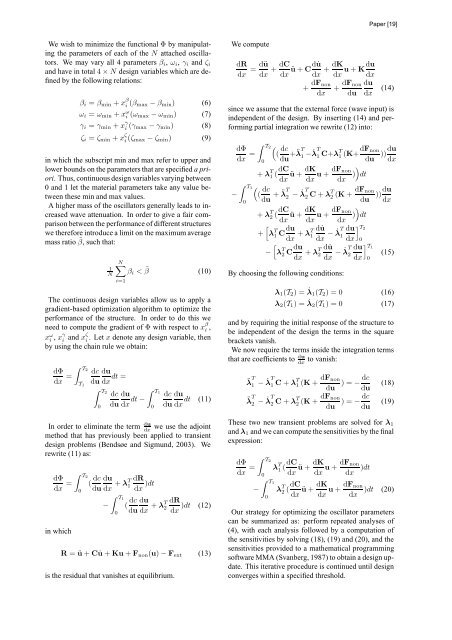WAVES AND VIBRATIONS IN INHOMOGENEOUS STRUCTURES ...
WAVES AND VIBRATIONS IN INHOMOGENEOUS STRUCTURES ...
WAVES AND VIBRATIONS IN INHOMOGENEOUS STRUCTURES ...
Create successful ePaper yourself
Turn your PDF publications into a flip-book with our unique Google optimized e-Paper software.
We wish to minimize the functional Φ by manipulating<br />
the parameters of each of the N attached oscillators.<br />
We may vary all 4 parameters βi, ωi, γi and ζi<br />
and have in total 4 × N design variables which are defined<br />
by the following relations:<br />
βi = βmin + x β<br />
i (βmax − βmin) (6)<br />
ωi = ωmin + x ω i (ωmax − ωmin) (7)<br />
γi = γmin + x γ<br />
i (γmax − γmin) (8)<br />
ζi = ζmin + x ζ<br />
i (ζmax − ζmin) (9)<br />
in which the subscript min and max refer to upper and<br />
lower bounds on the parameters that are specified a priori.<br />
Thus, continuous design variables varying between<br />
0 and 1 let the material parameters take any value between<br />
these min and max values.<br />
A higher mass of the oscillators generally leads to increased<br />
wave attenuation. In order to give a fair comparison<br />
between the performance of different structures<br />
we therefore introduce a limit on the maximum average<br />
mass ratio ˜ β, such that:<br />
1<br />
N<br />
N<br />
βi < ˜ β (10)<br />
i=1<br />
The continuous design variables allow us to apply a<br />
gradient-based optimization algorithm to optimize the<br />
performance of the structure. In order to do this we<br />
need to compute the gradient of Φ with respect to x β<br />
i ,<br />
xω i , xγ<br />
i and xζ<br />
i . Let x denote any design variable, then<br />
by using the chain rule we obtain:<br />
dΦ<br />
dx =<br />
T2<br />
dc du<br />
dt =<br />
T1 du dx<br />
T2 T1<br />
dc du dc du<br />
dt − dt (11)<br />
0 du dx 0 du dx<br />
In order to eliminate the term du<br />
dx we use the adjoint<br />
method that has previously been applied to transient<br />
design problems (Bendsøe and Sigmund, 2003). We<br />
rewrite (11) as:<br />
dΦ<br />
dx =<br />
in which<br />
T2<br />
0<br />
( dc du<br />
du<br />
dR<br />
dx )dt<br />
dx + λT1 T1<br />
− (<br />
0<br />
dc du<br />
du dx + λT2 dR<br />
)dt (12)<br />
dx<br />
R = ü + C ˙u + Ku + Fnon(u) − Fext (13)<br />
is the residual that vanishes at equilibrium.<br />
We compute<br />
dR<br />
dx<br />
= dü<br />
dx<br />
dC ˙u<br />
+ ü + Cd<br />
dx dx<br />
+ dFnon<br />
dx<br />
dK<br />
+ u + Kdu<br />
dx dx<br />
+ dFnon<br />
du<br />
du<br />
dx<br />
(14)<br />
since we assume that the external force (wave input) is<br />
independent of the design. By inserting (14) and performing<br />
partial integration we rewrite (12) into:<br />
−<br />
dΦ<br />
dx =<br />
T1<br />
0<br />
T2<br />
0<br />
<br />
( dc<br />
du +¨ λ T<br />
1 − ˙ λ T<br />
1 C+λT1 (K+dFnon<br />
du ))du<br />
dx<br />
+ λ T 1 ( dC dK dFnon<br />
ü + u +<br />
dx dx dx )<br />
<br />
dt<br />
<br />
( dc<br />
du + ¨ λ T<br />
2 − ˙ λ T<br />
2 C + λT dFnon<br />
2 (K +<br />
du ))du<br />
dx<br />
+ λ T 2 ( dC dK dFnon<br />
ü + u +<br />
dx dx dx )<br />
<br />
dt<br />
<br />
+ λ T 1 C du<br />
dx + λT d ˙u<br />
1<br />
dx − ˙ λ T du<br />
T2 1<br />
dx 0<br />
<br />
− λ T 2 C du<br />
dx + λT d ˙u<br />
2<br />
dx − ˙ λ T du<br />
T1 2 (15)<br />
dx 0<br />
By choosing the following conditions:<br />
λ1(T2) = ˙ λ1(T2) = 0 (16)<br />
λ2(T1) = ˙ λ2(T1) = 0 (17)<br />
and by requiring the initial response of the structure to<br />
be independent of the design the terms in the square<br />
brackets vanish.<br />
We now require the terms inside the integration terms<br />
to vanish:<br />
that are coefficients to du<br />
dx<br />
¨λ T<br />
1 − ˙ λ T<br />
¨λ T<br />
2 − ˙ λ T<br />
1 C + λ T 1 (K + dFnon dc<br />
) = −<br />
du du<br />
2 C + λ T 2 (K + dFnon dc<br />
) = −<br />
du du<br />
(18)<br />
(19)<br />
These two new transient problems are solved for λ1<br />
and λ1 and we can compute the sensitivities by the final<br />
expression:<br />
dΦ<br />
dx =<br />
T2<br />
−<br />
λ<br />
0<br />
T 1 (dC<br />
dx<br />
T1<br />
λ<br />
0<br />
T 2 (dC<br />
dx<br />
dK dFnon<br />
ü + u +<br />
dx dx )dt<br />
ü + dK<br />
dx<br />
dFnon<br />
u + )dt (20)<br />
dx<br />
Our strategy for optimizing the oscillator parameters<br />
can be summarized as: perform repeated analyses of<br />
(4), with each analysis followed by a computation of<br />
the sensitivities by solving (18), (19) and (20), and the<br />
sensitivities provided to a mathematical programming<br />
software MMA (Svanberg, 1987) to obtain a design update.<br />
This iterative procedure is continued until design<br />
converges within a specified threshold.

















